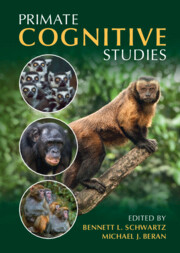Book contents
- Primate Cognitive Studies
- Primate Cognitive Studies
- Copyright page
- Contents
- Figures
- Tables
- Contributors
- Acknowledgments
- 1 The Purpose of Primate Cognitive Studies
- 2 A History of Primates Studying Primates
- 3 Genetic and Environmental Influences on Chimpanzee Brain and Cognition
- 4 The Evolution of Cognition in Primates, Including Humans
- 5 State of the Field
- 6 Current Perspectives on Primate Perception
- 7 The Comparative Study of Categorization
- 8 Numerical Cognition in Nonhuman Primates
- 9 The Natural History of Primate Spatial Cognition
- 10 Progress and Prospects in Primate Tool Use and Cognition
- 11 Sequencing, Artificial Grammar, and Recursion in Primates
- 12 The Evolution of Episodic Cognition
- 13 Metacognition
- 14 Bridging the Conceptual Gap between Inferential Reasoning and Problem Solving in Primates
- 15 The Eyes Have It
- 16 Social Cooperation in Primates
- 17 Primate Communication
- 18 Theory of Mind in Nonhuman Primates
- 19 A Requiem for Ape Language Research
- 20 Primate Empathy
- 21 Replication and Reproducibility in Primate Cognition Research
- 22 Ethical Considerations in Conducting Primate Cognition Research
- 23 Collaboration and Open Science Initiatives in Primate Research
- 24 Studying Primate Cognition
- 25 Do Monkeys Belong in the Ape House?
- Index
- References
4 - The Evolution of Cognition in Primates, Including Humans
Published online by Cambridge University Press: 28 July 2022
- Primate Cognitive Studies
- Primate Cognitive Studies
- Copyright page
- Contents
- Figures
- Tables
- Contributors
- Acknowledgments
- 1 The Purpose of Primate Cognitive Studies
- 2 A History of Primates Studying Primates
- 3 Genetic and Environmental Influences on Chimpanzee Brain and Cognition
- 4 The Evolution of Cognition in Primates, Including Humans
- 5 State of the Field
- 6 Current Perspectives on Primate Perception
- 7 The Comparative Study of Categorization
- 8 Numerical Cognition in Nonhuman Primates
- 9 The Natural History of Primate Spatial Cognition
- 10 Progress and Prospects in Primate Tool Use and Cognition
- 11 Sequencing, Artificial Grammar, and Recursion in Primates
- 12 The Evolution of Episodic Cognition
- 13 Metacognition
- 14 Bridging the Conceptual Gap between Inferential Reasoning and Problem Solving in Primates
- 15 The Eyes Have It
- 16 Social Cooperation in Primates
- 17 Primate Communication
- 18 Theory of Mind in Nonhuman Primates
- 19 A Requiem for Ape Language Research
- 20 Primate Empathy
- 21 Replication and Reproducibility in Primate Cognition Research
- 22 Ethical Considerations in Conducting Primate Cognition Research
- 23 Collaboration and Open Science Initiatives in Primate Research
- 24 Studying Primate Cognition
- 25 Do Monkeys Belong in the Ape House?
- Index
- References
Summary
Cognition is the use of information to solve problems, and the evolution of cognition is the natural history of the application of problem-solving capacities to adaptive problems. The ecological contexts in which primates apply their cognitive capacities vary substantially, and therefore the specific problems pertaining to fitness – finding mates, finding food, predator avoidance, and so forth – elicit systematic patterns of comportment through these different environments. A central debate in comparative cognition concerns the degree to which cognitive abilities are shaped by natural selection: this is the question of whether any given problem-solving skill reflects the application of domain-general or domain-specific cognitive capacities. The debate over whether the demands of foraging or the complexity of the social environment exerts the greater force on brain evolution and behavior exemplifies that the kinds of questions that can be asked about cognitive evolution significantly depend on one’s prior commitment to the domain-specificity of adaptive behavior. It remains a relatively open question whether there are cognitive specializations for navigating the physical world that are qualitatively distinct from specializations for navigating the social world. There is a panoply of investigative methods for eliciting problem-solving behavior in captive populations of primates, but there is also an emerging tension between proponents of ecological and internal validity, respectively. Here, I will argue that artificial, captive environments are, nevertheless, ecologically comprised and that the study of captive animals follows a long tradition of perturbation studies in ethology. I will finish with a number of case studies of primate cognition from both wild and captive environments.
Keywords
- Type
- Chapter
- Information
- Primate Cognitive Studies , pp. 57 - 87Publisher: Cambridge University PressPrint publication year: 2022

